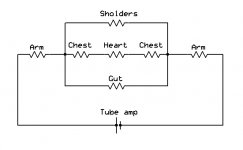In theory no, if AC makes yo rmuscles spasm in contraction. The short time around zero-crossing is less than your reaction time...............
I did add the 'joker' emoticon to the end of my post, I was joking.
Having touched both the UK Mains at 230V AC and Rectified UK Mains at approx 340V DC I still maintain that 'given a choice'
haha that made my day+1
I'll take AC over DC anytime. It does go to 0V now and again during its cycle so you do get the opportunity of letting go!!
In theory no, if AC makes yo rmuscles spasm in contraction. The short time around zero-crossing is less than your reaction time.
Very true !
For my work, I'm in a high DC voltage environment, from 100 V to 25 KV.
I experienced the full range shocks, I am a little distracted...
In addition, the high voltage is somewhat "capricious"
When I discharge the 25KV from a CRT, current often prefer to spend on me, instead of the cable.
I have also had close encounters with 220 VAC, believe me, the AC is worse, by far.

Having touched both the UK Mains at 230V AC and Rectified UK Mains at approx 340V DC I still maintain that 'given a choice'I'd prefer
the AC. The DC hurt more.
It is not about pain, but the risk of life.
I assure you, 100 KV sparks from a Van der Graaf Generator with a small sphere, are very painful, but harmless.
It is not about pain, but the risk of life.
I assure you, 100 KV sparks from a Van der Graaf Generator with a small sphere, are very painful, but harmless.
I assure you, I am fully aware of what a Van der Graaf generator feels like.
This thread has got a liitle silly (I realise I am partly to blame) and off topic.
Let's just agree that a 'Shock' is a shock and it shocks and maybe even hurts a bit when you receive one and if you survive, you live and learn from your mistake and don't do it again in the same way.
And we must be aware that it isn't the Voltage that will kill you but the amount of Current that passes through you which can stop your Heart. Remember the old saying...............?
''It's the Volts that Jolts and the mills that Kills'' !!!
The use of a Switch Mode Power Supply for a Valve Amp is an interesting thought and as has been discussed extreme care should be excercised if implemented.
The outputs from one are isolated from the Mains Supply Voltage and will be OK but to utilise the 340 Volt Rectified Mains input Voltage (UK) should not be done.
I do like the idea of using a SMPS from a Plasma TV, this could prove interesting and I may just try it.
Cheers All,
JC
That whole saying is somewhat misleading to the average Joe. They may start thinking the 650a battery in the car is worse then the 15a circuit in the house. Fact is you need both voltage and current to kill you starting with enough volts across your heart to draw a current high enough to cause fibrillation. Your body is just a large resistor. v=ir
Still staying Off Topic then?
Wikipedia has this to say............
''Factors in lethality of electric shock.
The lethality of an electric shock is dependent on several variables:
Current. The higher the current, the more likely it is lethal. Since current is proportional to voltage when resistance is fixed (ohm's law), high voltage is an indirect risk for producing higher currents.
Duration. The longer the duration, the more likely it is lethal—safety switches may limit time of current flow
Pathway. If current flows through the heart muscle, it is more likely to be lethal.
High voltage (over about 600 volts). In additon to greater current flow, high voltage may cause dielectric breakdown at the skin, thus lowering skin resistance and allowing further increased current flow...................''
All about the Current.
You are right in the fact that you need both but it's the current flow through the heart that will stop it from beating. This current can be found from a Car Battery or the Mains Supply in the house.
Directly applied and irrespective of the Voltage, only 10uA will stop your Heart.
Wikipedia has this to say............
''Factors in lethality of electric shock.
The lethality of an electric shock is dependent on several variables:
Current. The higher the current, the more likely it is lethal. Since current is proportional to voltage when resistance is fixed (ohm's law), high voltage is an indirect risk for producing higher currents.
Duration. The longer the duration, the more likely it is lethal—safety switches may limit time of current flow
Pathway. If current flows through the heart muscle, it is more likely to be lethal.
High voltage (over about 600 volts). In additon to greater current flow, high voltage may cause dielectric breakdown at the skin, thus lowering skin resistance and allowing further increased current flow...................''
All about the Current.
You are right in the fact that you need both but it's the current flow through the heart that will stop it from beating. This current can be found from a Car Battery or the Mains Supply in the house.
Directly applied and irrespective of the Voltage, only 10uA will stop your Heart.
Last edited:
Ha, ha ... this reminds me of my first post on the forum, I needed help, but no medical help. 
http://www.diyaudio.com/forums/tubes-valves/175624-my-first-amp.html
Without being a doctor, I would say that what kills is the energy absorbed in a certain time interval.
Since the human body in general obeys Ohm's law, that energy, can be expressed in terms of the current and/or voltage.
W = i^2 R = i V = V^2/R [W] = J/s
When finished the medical discussion, if I may, I will relate my experiences with audio PSUs.
http://www.diyaudio.com/forums/tubes-valves/175624-my-first-amp.html
Without being a doctor, I would say that what kills is the energy absorbed in a certain time interval.
Since the human body in general obeys Ohm's law, that energy, can be expressed in terms of the current and/or voltage.
W = i^2 R = i V = V^2/R [W] = J/s
When finished the medical discussion, if I may, I will relate my experiences with audio PSUs.
...................the aerodynamic drag coefficient of supersonic cats.................
Now there's a Topic!!!!
but it's the current flow through the heart that will stop it from beating. This current can be found from a Car Battery or the Mains Supply in the house.
I agree that current is the crucial point.
I don't agree that a car battery is capable to deliver a deadly current. Car batteries are designed to deliver several 100A into a low-resistance load. But to pass the (commonly accepted) critical limit of 20mA across your body, you would need a 'load resistance' of 600 ohms. The resistance of your skin is in the kohms range already, depending on factors like moisture or skin-penetrating electrodes. The current path across the body has resistance in the kohm range too, mainly consisting of 'salt water' electrolyte.
Car batteries are dangerous because of the secondary effects: The high current capability into low load resistances will cause shorting metal parts to heat up quickly and cause burns.
According to German electrical safety regulations, 12V are within the SELV (safety extra low voltage) range and do not need any protection against being touched, as they are safe even for children or small animals.
See: Extra-low voltage - Wikipedia, the free encyclopedia
Directly applied and irrespective of the Voltage, only 10uA will stop your Heart.
Do you have any sources for that value? However, no one is going to apply voltage directly to the heart - and for a current path across the body, 20mA are the commonly accepted safety limit.
Rundmaus
PS. A note on 'irrespective of the voltage': Any current flow in the body involves a resistance, following more or less Ohm's law. Therefore current is *never* irrespective of the voltage, both are in a fixed relation determined by the resistance!
I believe the 10uA is "through the heart".
Here are some references showing values from 0.06A to a high of 0.2A.
I haven't read the cited references, however most I have read refer to dry skin contact. Wet skin can reduce the required current as can broken skin contact as both reduce the contact resistance.
Electric Current Needed to Kill a Human
Here are some references showing values from 0.06A to a high of 0.2A.
I haven't read the cited references, however most I have read refer to dry skin contact. Wet skin can reduce the required current as can broken skin contact as both reduce the contact resistance.
Electric Current Needed to Kill a Human
I believe the 10uA is "through the heart".
I haven't read the references yet, but this sounds reasonable, as the 20mA I remember were total current across the body. Could be that 20mA on a random body path is equal to a fraction of 10uA directly across the heart.
Rundmaus
I have electric fencing for my critters. Most charging units are sold by the number of joules they put out. Typically the voltage on my fencing is 6k to 7k depending on the weather. I have been shocked by it many times. You get an understanding of why the critters respect it. It puts out pulses of voltage about every second. I think my current charger is 0.5 joules. It's a nasty shock..much stronger than touching the 120v AC in my house.
........PS. A note on 'irrespective of the voltage': Any current flow in the body involves a resistance, following more or less Ohm's law. Therefore current is *never* irrespective of the voltage, both are in a fixed relation determined by the resistance!
Not great English!
Perhaps I should have said irrespective of the source of the Voltage?
And English is my first (and only!) language
Apologies.
I don't agree that a car battery is capable to deliver a deadly current.
Exactly; you're never going to get a shock from 12V-24V. People something *think* they've been shocked by a car battery, when really it is the high voltage flyback from the start motor (or whatever) causing the voltage across the terminals to reach hundreds of volts (the battery has some internal resistance, remember).
not sure but defib used at heart chirurgy runs way lower voltageI agree that current is the crucial point. I don't agree that a car battery is capable to deliver a deadly current.
other point of view-low voltage hi current, not enough to kill, but enough to burn skin on hot surface

- Status
- This old topic is closed. If you want to reopen this topic, contact a moderator using the "Report Post" button.
- Home
- Amplifiers
- Tubes / Valves
- Power supply options for tube amplifiers.

